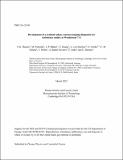| dc.contributor.author | Hansen, Soren K. | en_US |
| dc.contributor.author | Porkolab, Miklos | en_US |
| dc.contributor.author | Bähner, J.-P. | en_US |
| dc.contributor.author | Huang, Z. | en_US |
| dc.contributor.author | von Stechow, A. | en_US |
| dc.contributor.author | Grulke, O. | en_US |
| dc.contributor.author | Edlund, E.M. | en_US |
| dc.contributor.author | Wilms, F. | en_US |
| dc.contributor.author | Bañón Navarro, A. | en_US |
| dc.contributor.author | Jenko, F. | en_US |
| dc.contributor.author | Sánchez, E. | en_US |
| dc.date.accessioned | 2025-03-21T20:23:49Z | |
| dc.date.available | 2025-03-21T20:23:49Z | |
| dc.date.issued | 2022-03 | |
| dc.identifier | 22ja089 | |
| dc.identifier.uri | https://hdl.handle.net/1721.1/158745 | |
| dc.description | Submitted for publication in Plasma Physics and Controlled Fusion | |
| dc.description.abstract | We present a synthetic phase contrast imaging (PCI) diagnostic for studying turbulence at the Wendelstein 7-X (W7-X) stellarator. We first describe the implemented instrument response model, which captures diffraction effects, detector noise, and the long-wavelength cutoff due to the phase plate of the PCI system. To verify the instrument response model, we show that it is capable of reproducing the PCI signal generated by the sound wave speaker used for calibration at W7-X. Next, we discuss the calculation of synthetic PCI signals based on the global, nonlinear gyrokinetic codes GENE-3D and EUTERPE, including results from some of the first stellarator simulations of this type with kinetic electrons (KEs) in GENE-3D. While the simulations used in this work lack a neoclassical radial electric field, which is crucial for reproducing experimental PCI signals, they do indicate that the dominant rotation direction and velocities of the turbulent fluctuations can be inferred from the wave number-frequency spectra of the PCI signals, as expected. The synthetic PCI wave number spectra are further shown to be similar to those of the line-integrated fluctuating electron density, with distinct differences between adiabatic and KE simulations, explainable by previously published turbulence models. For example, the wave number spectra of all adiabatic electron simulations analyzed here follow a power law with an exponent close to −5 for sufficiently large wave numbers. This indicates that universal features of electron density turbulence at W7-X may be studied using the PCI system. | |
| dc.publisher | IOP | en_US |
| dc.relation.isversionof | doi.org/10.1088/1361-6587/ac7ad2 | |
| dc.source | Plasma Science and Fusion Center | en_US |
| dc.title | Development of a synthetic phase contrast imaging diagnostic for turbulence studies at Wendelstein 7-X | en_US |
| dc.type | Article | en_US |
| dc.contributor.department | Massachusetts Institute of Technology. Plasma Science and Fusion Center | |
| dc.relation.journal | Plasma Physics and Controlled Fusion | |
